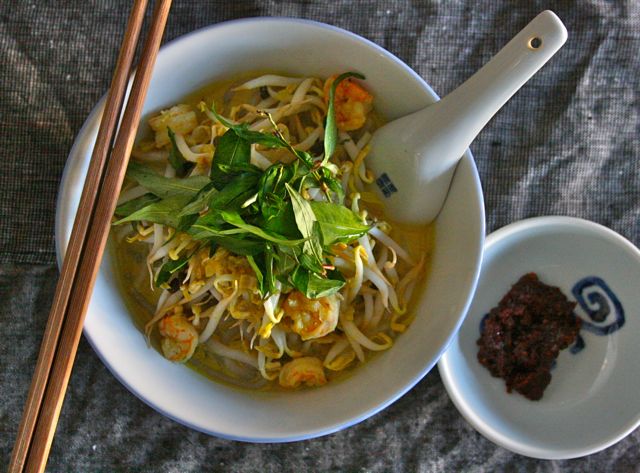
こちらに来てしばらく経つのに、最近初めてペナンらしいものを食べました。それがラクサ。そういえば、街中のあちこちに「Laksa」の看板を見かけます。
米の麺を甘酸っぱいココナツミルクベースのスープで食べます。ハーブやスパイスがたっぷり入っています。そのうちの一つが「ラクサリーフ」というハーブ。どくだみのような香りで、ベトナムミントとも呼ばれますが、調べてみたらなんと藍草の親戚でした!そういえば、茎の感じ、葉っぱと花の形もよく似ています。しかし、なんとこれが辛いのです。
市場のテンペおじさん(と、呼んでいる)から買った、おじさん製サンバルペースト(唐辛子とニンニク)を使って、サンバルソースも作りました。これを作ったラクサにいれると、途端に味が締まるので不思議。
屋台やレストランも当たり外れが大きくて、今までおいしいと思ったものはタイ料理やインド料理ばかりでした。でも、せっかくここにいるのだから、その間にペナンらしいものをもっと食べてみないと。
ちなみに「ラクサ」というのは、サンスクリット語の「たくさんの」という言葉が語源だそうです。ちなみに、服を染めるのに使う「ラック」も同じ意味なんですよね(虫の巣が沢山集まったものがラックなのです)。なるほど。
I tried my hand at making “laksa,” a Malaysian noodle dish, a couple times recently. I used Japanese kombu to make a broth to which I added freshly squeezed coconut milk, and finely chopped shallots, lemon grass, and galangal. Afterward, I added small shrimp, thin slices of sautéed chicken breast, mung bean sprouts, and as a garnish and for added flavor, Vietnamese mint called “duan laksa” (laksa leaf) here. Not a true mint, this herb is used throughout SE Asia, and has a heavy, peppery taste.
At the table we added some sambal sauce, which I prepared from a base sauce homemade by a local grocer, basically chili and garlic blended together, which I sautéed with some brown sugar and salt. We added “naam plaa” and lime juice at the table to taste. Locally produced noodles for laksa were used. These rice noodles are thick and must be well boiled. (In true Penang laksa, tamarind juice is added during cooking, instead of lime juice, to add sourness.)
